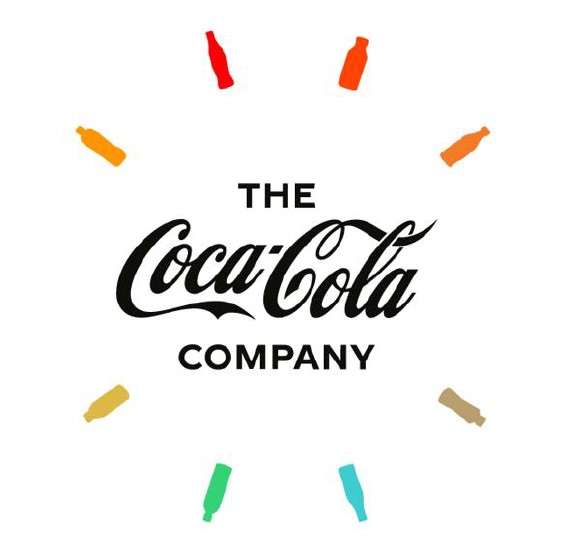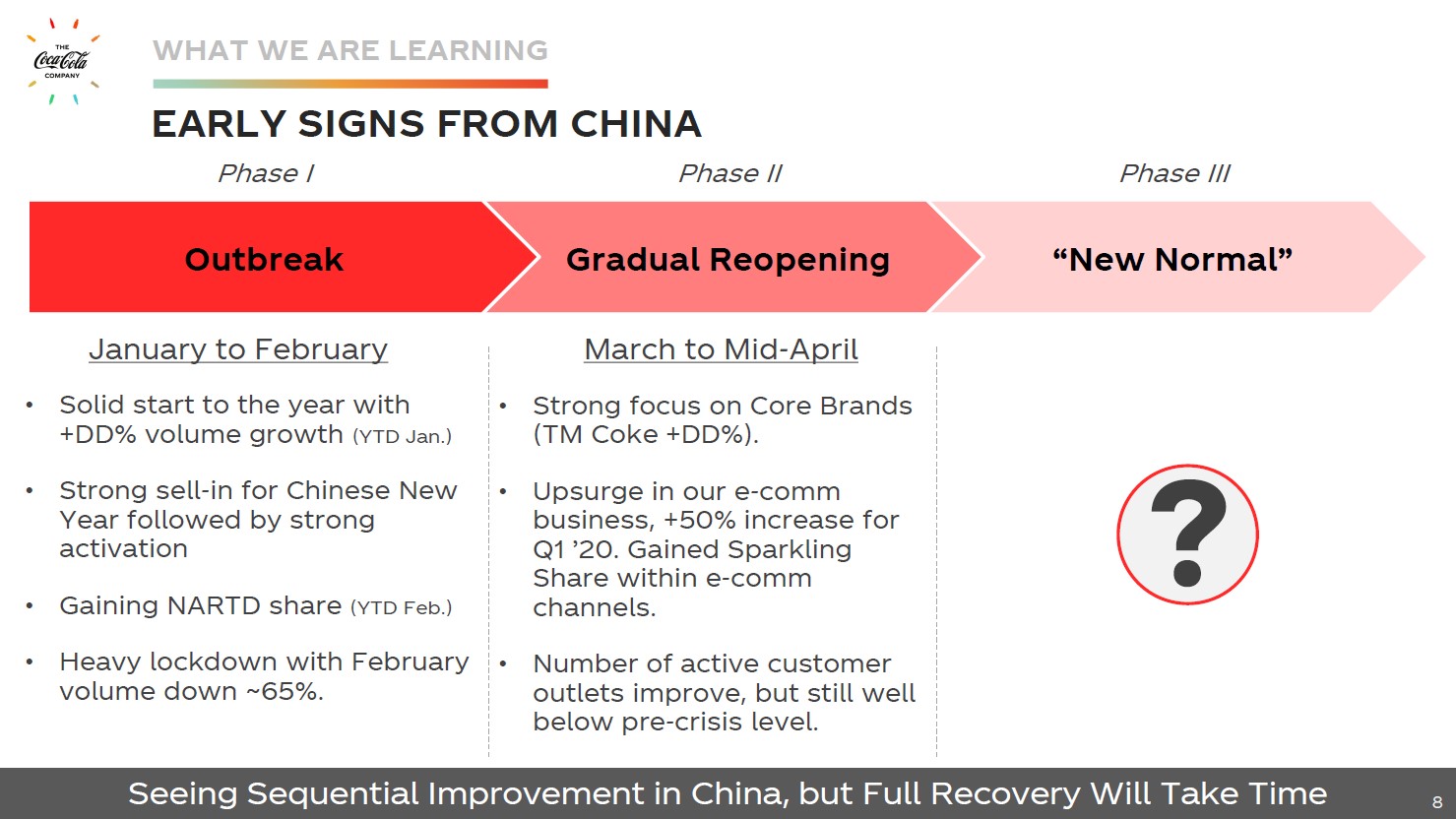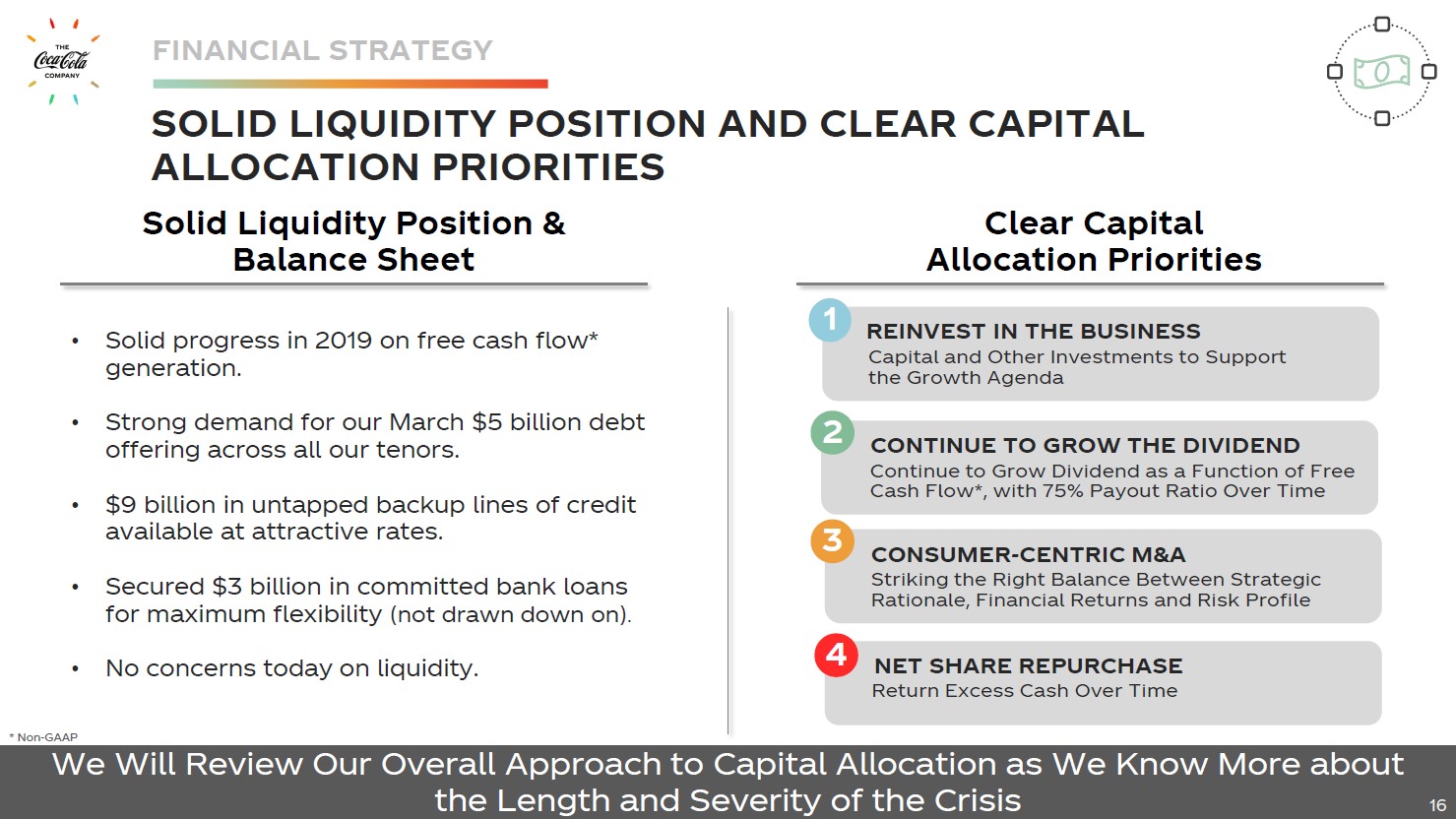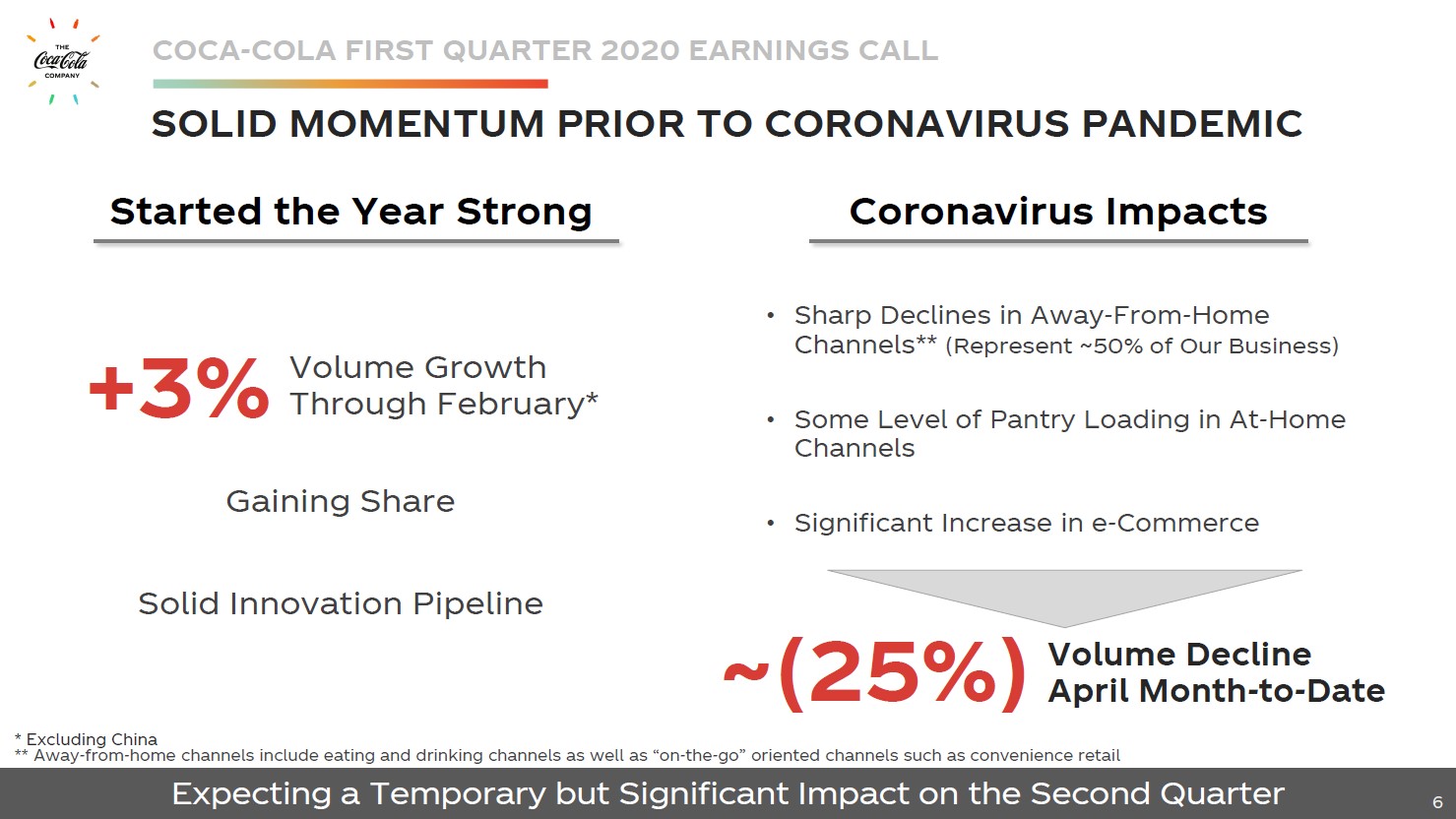Member LoginDividend CushionValue Trap |
Coca-Cola’s Debt Load Makes It Difficult to Navigate Rough Market Conditions
publication date: Apr 27, 2020
|
author/source: Callum Turcan
Image Source: The Coca-Cola Company – First Quarter Fiscal 2020 Earnings IR Presentation By Callum Turcan On April 21, The Coca-Cola Company (KO) reported first-quarter fiscal 2020 earnings (period ended March 27, 2020) that beat both consensus top- and bottom-line estimates, and furthermore, flat organic sales beat consensus estimates as well (which analysts expected would decline modestly year-over-year). Coca-Cola’s Asia Pacific business was weakened by the coronavirus (‘COVID-19’) pandemic and organic revenues in the region (an adjusted non-GAAP figure) were down 7% year-over-year last fiscal quarter. Strong growth in North America (organic revenues were up 4% year-over-year) and Latin America (organic revenues were up a whopping 13% year-over-year) due to greater sales volumes and favorable price increases/product mix shifts offset weakness in the Asia Pacific region in the fiscal first quarter. However, please note that this picture will likely change in the second fiscal quarter due to the spread of the pandemic worldwide. Overview When looking at Coca-Cola’s performance on a GAAP basis, its revenues were down 1% year-over-year (due primarily to the negative impact of the pandemic) and its operating income was down 2% year-over-year due to rising ‘other operating charges’ as Coca-Cola dealt with COVID-19 last fiscal quarter. Coca-Cola’s GAAP diluted EPS surged by 65% year-over-year, hitting $0.64 last fiscal quarter, due to the firm reporting a large non-operating activity related gain and due to its corporate income taxes moving significantly lower. As the firm pared back its share buybacks last fiscal quarter, the company’s outstanding diluted share count grew marginally year-over-year. Like many other firms, Coca-Cola pulled its full-year guidance for 2020 given the inability to forecast the impact COVID-19 will have on its future performance. Its business in North America and Europe will take a hit as stay-at-home orders and other quarantine measures are reducing demand from restaurants, movie theaters, and sports stadiums for its concentrates and other products. That will likely hold true elsewhere as well. While China’s economy is in the process of opening back up, it’s a slow process and recently, Beijing once again shut down gyms in the city over fears of a second wave of infections. When quarantine measures will be relaxed remains to be seen and will vary from nation to nation, and even region to region (i.e. US states will reopen their economies at different times). In the upcoming graphic down below, Coca-Cola provides an overview of what the company has been experiencing in China as the economy has been slowly reopening. Coca-Cola is seeing a lot of demand for its products through e-commerce channels; however, the number of its “active customer outlets” is still subdued (for various reasons, including large locations like movie theaters in China getting shut down again in order to prevent a second wave of infections). To speed up the recovery process in China, Coca-Cola is planning several promotional deals and enhancing its in-store product placement strategy, according to management during the firm’s latest quarterly conference call.
Image Shown: Coca-Cola is seeing improvement in its Chinese operations since authorities began opening the economy up after shutting the economy down in early-2020 to prevent the spread of COVID-19, however, the firm notes the recovery process is in its early stages. Image Source: Coca-Cola – First Quarter Fiscal 2020 Earnings IR Presentation Financial Overview From the end of fiscal 2019 to the end of the first quarter of fiscal 2020, Coca-Cola’s combined cash and cash equivalents and short-term investments position grew by $7.3 billion (up 92%) to $15.3 billion. That cash build was made possible through debt issuance, as Coca-Cola’s total debt load (inclusive of short-term maturities) grew by $7.6 billion (up 18%) during this period, reaching $50.4 billion. Coca-Cola completed a large $5.0 billion debt issuance on March 25 which included; $1.0 billion in 2.95% Notes due 2025, $1.0 billion in 3.375% Notes due 2027, $1.25 billion in 3.450% Notes due 2030, $0.5 billion in 4.125% Notes due 2040, and $1.25 billion in 4.200% Notes due 2050. That bond issuance significantly bolstered its liquidity position, given the firm had $19.3 billion in short-term debt at the end of its last fiscal quarter, and Coca-Cola’s cost of debt is relatively attractive. As an aside, Coca-Cola also exited the fiscal first quarter with $2.4 billion in marketable securities, $18.0 billion in equity method investments, and $0.7 billion in other investments. Please note a lot of those line-items represent strategic investments to Coca-Cola. As it relates to its equity method investments, Coca-Cola notes that (from its fiscal 2019 Annual Report): The Company's equity method investments include, but are not limited to, our ownership interests in Coca-Cola European Partners plc (CCEP), Monster (MNST), AC Bebidas, Coca-Cola FEMSA (KOF), Coca-Cola HBC AG ("Coca-Cola Hellenic") [CCHGY] and Coca-Cola Bottlers Japan Holdings Inc. ("CCBJHI"). As of December 31, 2019, we owned approximately 19 percent, 19 percent, 20 percent, 28 percent, 23 percent and 19 percent, respectively, of these companies' outstanding shares. As of December 31, 2019, our investments in our equity method investees in the aggregate exceeded our proportionate share of the net assets of these equity method investees by $8,679 million. This difference is not amortized. Coca-Cola’s free cash flows last fiscal quarter came out to just $0.2 billion due to a large working capital build and pressures at its Asia Pacific business. Share buybacks consumed $0.1 billion in cash and the firm’s fiscal first quarter dividend (which was increased by 2.5% sequentially in February 2020 and that represents Coca-Cola’s 58th consecutive year of payout growth, highlighting the firm’s Dividend Aristocrat status) will be paid out in April 2020. Additionally, Coca-Cola’s fourth quarter fiscal 2019 dividend was paid out in December 2019. Shares of KO yield ~3.6% as of this writing. Coca-Cola, on an annual basis, is very free cash flow positive but we caution that its very large net debt load is a major hindrance to the strength of its dividend payout coverage. In the upcoming graphic down below, Coca-Cola highlights its liquidity position and where the firm can access additional liquidity as needed. Access to liquidity could come from its revolving credit facilities (with $9.0 billion in total borrowing capacity, which according to its fiscal 2019 Annual Report mature at various times between 2020 and 2024) and committed bank loans.
Image Shown: Due to Coca-Cola’s apparent ability to borrow, management is not worried about the firm’s liquidity position. Image Source: Coca-Cola – First Quarter Fiscal 2020 Earnings IR Presentation Operational Commentary Management communicated to investors during Coca-Cola’s latest quarterly conference call that the fiscal second quarter would be a brutal one. Here’s what the firm had to say: “…[W]e expect a temporary, but significant impact on our business in the second quarter, primarily coming from the slowdown in our away-from-home business. For context, if we look at our April month to-date trends, we are seeing volumes down globally approximately 25%, driven by the sharp declines in our away-from-home businesses. Fortunately, based on the latest projections, we do expect the second quarter to be the most severely impacted.” While e-commerce sales channels are offering some relief, that hasn’t been enough to offset the negative impact from containment efforts and the “cocooning” of households in many nations worldwide. Management provides an overview of the situation in the upcoming graphic down below.
Image Shown: Coca-Cola’s second fiscal quarter will be brutal, but management appears optimistic that the firm’s performance will recover. Image Source: Coca-Cola – First Quarter Fiscal 2020 Earnings IR Presentation Management mentioned that while Coca-Cola doesn’t know when a recovery will occur, the firm is positioning itself to capitalize on an uptick in demand when quarantine efforts are relaxed and (in theory) demand picks up (from Coca-Cola’s latest quarterly conference call): “Looking ahead, we may not know the exact shape of the recovery, but we are taking actions today to be prepared for the future. For the recovery phase, RGM [revenue growth management] is key as we prepare to strike the right balance of affordability on recruitment packs in addition to premium offerings. This is one area where we are much better positioned versus our system 10 years ago, when our portfolio and SKU [stock-keeping unit] optionality was not nearly as sophisticated as it is today. We'll also embrace some seismic consumer behavior shifts that are taking place, especially in e-commerce. We believe the accelerating expansion of the channel is sustainable and we want to continue to be well-positioned for long-term growth. We are investing in digital capabilities to strengthen consumer connections and further piloting several different digital-enabled initiatives using fulfillment methods, whether B2B2Home [appears to be business-to-business-to-home] or D2C [direct-to-consumer] platforms in many countries to capture online demand for at-home consumption in the future. We're seeing good results in these early days and are looking to scale similar partnerships with more customers.” While Coca-Cola is doing the right things operationally, the company’s eventual recovery would be a lot easier if it wasn’t contending with a mountain of debt. How the recovery process in China plays out offers a blueprint for what to expect in North America and Europe, keeping in mind the cultural and economic differences across these regions. Concluding Thoughts Our fair value estimate for Coca-Cola sits at $39 per share, and the top end of our fair value estimate range sits at $48 per share. Shares of KO are currently trading near $45 per share as of the end of the normal trading session on April 23 after pulling back substantially this year due to mounting fears over the pandemic. While Coca-Cola has ample access to liquidity, it will be tough sledding going forward until the “cocooning” of households ends worldwide and consumers start going back to restaurants, movie theaters, sports events, and other endeavors that often involve drinking a nice cold soda. We sincerely hope our members, their families, and their loved ones stay safe out there. ----- Nonalcoholic Beverages Industry – CCEP FIZZ KDP KO MNST PEP Related: KOF, CCGHY ---- Valuentum members have access to our 16-page stock reports, Valuentum Buying Index ratings, Dividend Cushion ratios, fair value estimates and ranges, dividend reports and more. Not a member? Subscribe today. The first 14 days are free. Callum Turcan does not own shares in any of the securities mentioned above. Some of the companies written about in this article may be included in Valuentum's simulated newsletter portfolios. Contact Valuentum for more information about its editorial policies.
|






0 Comments Posted Leave a comment